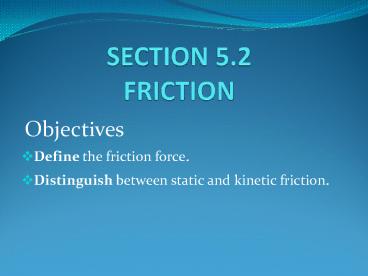SECTION 5.2 FRICTION - PowerPoint PPT Presentation
1 / 12
Title:
SECTION 5.2 FRICTION
Description:
Objectives Define the friction force. Distinguish between static and kinetic friction. INTRO Friction force opposing relative motion of 2 objects that are in contact. – PowerPoint PPT presentation
Number of Views:141
Avg rating:3.0/5.0
Title: SECTION 5.2 FRICTION
1
SECTION 5.2 FRICTION
- Objectives
- Define the friction force.
- Distinguish between static and kinetic friction.
2
INTRO
- Friction force opposing relative motion of 2
objects that are in contact. Examples tires on
road, shoes on ground. The direction of the
force is parallel to the surface and in a
direction that opposes the slipping of the 2
surfaces.
3
STATIC AND KINETIC FRICTION
- Kinetic Friction the force exerted on one
surface by a second surface when the 2 surfaces
rub against one another because one or both of
the surfaces are moving. Also called Sliding
Friction. - From Old Book
- Sliding Friction force between 2 surfaces in
relative motion. The force of sliding friction
is less than that of static friction. Thus a car
will stop faster if the wheels are not skidding. - To keep a book sliding at constant velocity on a
desk you must exert a constant force that is just
the same size as the frictional force but in the
opposite direction. - Experimentally it has been found that the force
of friction depends primarily on the force
pushing the surfaces together, FN, and on the
nature of the surfaces in contact. FN is the
force pushing the surfaces together (Normal or
Perpendicular Force)
4
STATIC AND KINETIC FRICTION
- Static Friction the force exerted on one
surface by a second surface when there is no
motion between the 2 surfaces. - From Old Book
- Static Friction force that opposes start of
motion between 2 surfaces. Static friction
forces have maximum values. - When the magnitude of your push on the box is
greater than the max value of the static friction
between the floor and the box, the box starts
moving. When the box starts to move the force of
friction decreases.
5
STATIC AND KINETIC FRICTION
- Once your force is greater than this maximum
STATIC Friction, the couch begins moving and
KINETIC Friction begins to act instead of static
friction. - You have Static Friction acting when trying to
get an object moving and once it is moving you
have Kinetic or Sliding Friction acting. - Go Over example from book dealing with figure 5.8
p. 126.
6
A MODEL FOR FRICTION FORCES
- On what does a Frictional Force depend?
- The materials that the surfaces are made of play
a role. - The normal force between the 2 objects. The
harder an object is pushed against the other, the
greater the force of Friction. - If you pull a block along a surface at a constant
velocity, according to Newtons Laws, the
Frictional Force must be equal and opposite to
the force with which you pull.
7
A MODEL FOR FRICTION FORCES
- Coefficient of Kinetic Friction - ratio of
frictional force and the normal force between 2
surfaces. It is indicated by the symbol ?. It
is a constant that depends on the 2 surfaces in
contact. This is for an object that is already
moving. - Kinetic Friction Force the force exerted on one
surface by a second surface when the 2 surfaces
rub against one another because one or both of
the surfaces are moving. It is equal to the
product of the coefficient of kinetic friction
and the normal force. - FFKinetic µKFN FF µFN
8
A MODEL FOR FRICTION FORCES
- Coefficient of Static Friction - ratio of
frictional force and the normal force between 2
surfaces. It is indicated by the symbol ?. It
is a constant that depends on the 2 surfaces in
contact. This is for an object you are trying to
get to move. - Static Friction Force - the force exerted on one
surface by a second surface when there is no
motion between the 2 surfaces. It is less than
or equal to the product of the coefficient of
static friction and the normal force. - FFStatic µSFN FF µFN
- The static Friction Force will increase up to a
maximum value before it is overcome and motion
starts.
9
A MODEL FOR FRICTION FORCES
- Do Example Problem 3 p. 128
- Fg mg 25(9.8) 245 N and Fg FN
- FPush µFN .2(245) 49 N (note .2 from
table 5.1) - Do Practice Problems p. 128 17-21
- Show and Go Over Table 5.1 p. 129
10
A MODEL FOR FRICTION FORCES
11
A MODEL FOR FRICTION FORCES
- Do Example Problem 4 p. 129
- FPush doubles to 98 N and FF original FPush
- FNet FPush FF
- ma 98 49
- 25a 49
- a 1.96 m/s2
- Do Practice Problems p. 130 22-26
12
IMPORTANT THINGS ABOUT FRICTION
- Important Things to remember about Friction
- Friction acts in the direction opposite to the
motion. - The magnitude of the force of friction depends on
the magnitude of the normal force between the 2
surfaces. - Multiplying the coefficient of static friction
and the normal force gives you the maximum static
friction force. - Do 5.2 Section Review p. 130 28-32 (SKIP 27
and 31)































